
Alexander Carrick
Encyclopedia

Scotland
Scotland is a country that is part of the United Kingdom. Occupying the northern third of the island of Great Britain, it shares a border with England to the south and is bounded by the North Sea to the east, the Atlantic Ocean to the north and west, and the North Channel and Irish Sea to the...
leading monumental sculptors
Sculpture
Sculpture is three-dimensional artwork created by shaping or combining hard materials—typically stone such as marble—or metal, glass, or wood. Softer materials can also be used, such as clay, textiles, plastics, polymers and softer metals...
of the early part of the 20th century. He was responsible for many architectural and ecclesiastical works as well as many war memorials executed in the period following World War I
World War I
World War I , which was predominantly called the World War or the Great War from its occurrence until 1939, and the First World War or World War I thereafter, was a major war centred in Europe that began on 28 July 1914 and lasted until 11 November 1918...
. As head of sculpture at Edinburgh College of Art
Edinburgh College of Art
Edinburgh College of Art is an art school in Edinburgh, Scotland, providing tertiary education in art and design disciplines for over two thousand students....
, and as a leading Academician of the Royal Scottish Academy
Royal Scottish Academy
The Royal Scottish Academy is a Scottish organisation that promotes contemporary Scottish art. Founded in 1826, as the Royal Institution for the Encouragement of the Fine Arts, the RSA maintains a unique position in Scotland as an independently funded institution led by eminent artists and...
(RSA), he also had a lasting influence on Scottish sculpture.
Early years
Alexander Carrick, the son of a blacksmithBlacksmith
A blacksmith is a person who creates objects from wrought iron or steel by forging the metal; that is, by using tools to hammer, bend, and cut...
, was born in 1882 in the small town of Musselburgh
Musselburgh
Musselburgh is the largest settlement in East Lothian, Scotland, on the coast of the Firth of Forth, six miles east of Edinburgh city centre.-History:...
, just east of Edinburgh
Edinburgh
Edinburgh is the capital city of Scotland, the second largest city in Scotland, and the eighth most populous in the United Kingdom. The City of Edinburgh Council governs one of Scotland's 32 local government council areas. The council area includes urban Edinburgh and a rural area...
. In 1897 he enrolled as a student at Edinburgh College of Art and was apprenticed as a stonemason working in the yard of one of the prominent monumental sculptors of the period, Birnie Rhind. He won the Queen's Prize allowing him to go to London to study for two years at the South Kensington College
Royal College of Art
The Royal College of Art is an art school located in London, United Kingdom. It is the world’s only wholly postgraduate university of art and design, offering the degrees of Master of Arts , Master of Philosophy and Doctor of Philosophy...
under the Belgian sculptor Professor Edouard Lanteri
Edouard Lanteri
Edouard Lanteri was a sculptor and medallist whose romantic French style of sculpting was seen as influential among exponents of New Sculpture.-Life history:...
. He then returned to Edinburgh, spending a further two years working under another of the leading Scottish sculptors of the period, Pittendrigh MacGillivray
James Pittendreigh MacGillivray
Dr. James Pittendrigh MacGillivray was a prominent Scottish sculptor. He was born in Inverurie, Aberdeenshire, the son of a sculptor, and studied under William Brodie and John Mossman...
.
In the years running up to World War I
World War I
World War I , which was predominantly called the World War or the Great War from its occurrence until 1939, and the First World War or World War I thereafter, was a major war centred in Europe that began on 28 July 1914 and lasted until 11 November 1918...
Carrick was to become a regular exhibitor at the RSA exhibitions, his exhibition works including ‘A Boy Putting a Stone’, ‘A Girl Skipping’, and ‘Saint Cecilia’. He also established his reputation as a monumental artist working on prestigious construction projects such as the Usher Hall
Usher Hall
Usher Hall is a concert hall, situated on Lothian Road, in the west end of Edinburgh, Scotland. It has hosted concerts and events since its construction in 1914 and can hold approximately 2,900 people in its recently restored auditorium, which is well loved by performers due to its acoustics...
and the Scotsman Building, both in Edinburgh; restoration works at Eilean Donan Castle and St. Magnus' Cathedral in Kirkwall
Kirkwall
Kirkwall is the biggest town and capital of Orkney, off the coast of northern mainland Scotland. The town is first mentioned in Orkneyinga saga in the year 1046 when it is recorded as the residence of Rögnvald Brusason the Earl of Orkney, who was killed by his uncle Thorfinn the Mighty...
; and also carrying out extensive work in the unusual Saint Conan’s Kirk at Loch Awe
Loch Awe
Loch Awe is a large body of water in Argyll and Bute, Scotland. It has also given its name to a village on its banks, variously known as Loch Awe, or Lochawe. There are islands within the loch such as Innis Chonnell and Inishail.- The loch :It is the third largest freshwater loch in Scotland with...
. Whilst at the Edinburgh College of Art, Carrick met his wife, Janet Ferguson MacGregor, who was studying painting there, and the couple were married in 1914. Their first child, Elizabeth, was born in 1915, (followed later by Anne, who herself became an artist).
World War I
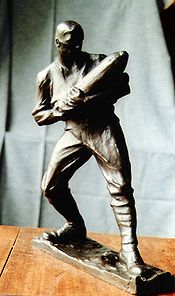
Royal Garrison Artillery
The Royal Garrison Artillery was an arm of the Royal Artillery that was originally tasked with manning the guns of the British Empire's forts and fortresses, including coastal artillery batteries, the heavy gun batteries attached to each infantry division, and the guns of the siege...
and served in Belgium
Belgium
Belgium , officially the Kingdom of Belgium, is a federal state in Western Europe. It is a founding member of the European Union and hosts the EU's headquarters, and those of several other major international organisations such as NATO.Belgium is also a member of, or affiliated to, many...
throughout the war (The location of sketches which he made at this time have been identified as lying just north of the village of Ypres
Ypres
Ypres is a Belgian municipality located in the Flemish province of West Flanders. The municipality comprises the city of Ypres and the villages of Boezinge, Brielen, Dikkebus, Elverdinge, Hollebeke, Sint-Jan, Vlamertinge, Voormezele, Zillebeke, and Zuidschote...
). On one occasion a shell prematurely exploded in his battery and he was badly shocked. Due to the epidemics sweeping the military hospitals at the time, he was left in the house of an old Belgian woman, who he remembered had simply allowed him to sleep for days at a time. In 1916 he modelled the figure of an artilleryman lifting a shell, ‘The Gunner’, which was exhibited at that year’s RSA Exhibition in Edinburgh and received some acclaim, including an article in ‘The Studio’ appearing in 1924. In 1918 he was elected an Associate of the Royal Scottish Academy while still in Belgium.
Post World War I
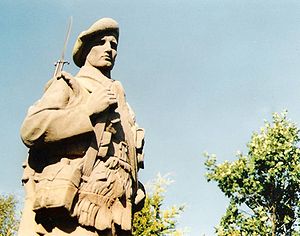
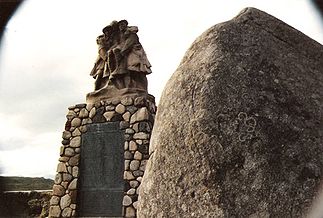
Killin
Killin is a village situated at the western head of Loch Tay in Stirling , Scotland....
, Oban
Oban
Oban Oban Oban ( is a resort town within the Argyll and Bute council area of Scotland. It has a total resident population of 8,120. Despite its small size, it is the largest town between Helensburgh and Fort William and during the tourist season the town can be crowded by up to 25,000 people. Oban...
, St Margaret's Hope
St Margaret's Hope
St Margaret's Hope, known locally as The Hope , is a village in the Orkney Islands, situated off the north-east coast of Scotland. It has a population of about 550, making it Orkney's third largest settlement after Kirkwall and Stromness....
, Kinghorn
Kinghorn
Kinghorn is a town in Fife, Scotland. A seaside resort with two beaches, Kinghorn Beach and Pettycur Bay, plus a fishing port, it stands on the north shore of the Firth of Forth opposite Edinburgh...
, Newburgh
Newburgh
-Places:Scotland*Newburgh, Fife, a former royal burgh*Newburgh, Aberdeenshire, a village*Newburgh, Borders, a village*Newburgh, Moray, a village*Newburgh, Orkney, a villageEngland*Newburgh, Lancashire, a village*Newburgh, North Yorkshire, a village...
and Auchtermuchty
Auchtermuchty
Auchtermuchty is a town in Fife, Scotland, situated beside Pitlour Hill nine miles north of Glenrothes. Until 1975 it was a royal burgh, established under charter of King James V in 1517. There is evidence of human habitation in the area dating back over 2,000 years, and the Romans are known to...
.

Pretoria
Pretoria is a city located in the northern part of Gauteng Province, South Africa. It is one of the country's three capital cities, serving as the executive and de facto national capital; the others are Cape Town, the legislative capital, and Bloemfontein, the judicial capital.Pretoria is...
. Carrick also executed figures in bronze
Bronze
Bronze is a metal alloy consisting primarily of copper, usually with tin as the main additive. It is hard and brittle, and it was particularly significant in antiquity, so much so that the Bronze Age was named after the metal...
, including the figures of soldiers for the Dornoch
Dornoch
Dornoch is a town and seaside resort, and former Royal burgh in the Highlands of Scotland. It lies on the north shore of the Dornoch Firth, near to where it opens into the Moray Firth to the east...
, Forres
Forres
Forres , is a town and former royal burgh situated in the north of Scotland on the Moray coast, approximately 30 miles east of Inverness. Forres has been a winner of the Scotland in Bloom award on several occasions...
, Blairgowrie
Blairgowrie and Rattray
Blairgowrie and Rattray and Raitear is possibly from an English language cognate of Gaelic ràth, meaning fortress + a Pictish term cognate with Welsh tref, meaning settlement) is a twin burgh in Perth and Kinross, Scotland. Amongst locals, the town is colloquially known simply as "Blair"...
and Walkerburn
Walkerburn
Walkerburn is a small village in the Scottish Borders area of Scotland, on the A72 about from Peebles and from Galashiels.Founded in 1854 around the mill to house the workers, Walkerburn now has a population of around 660.-External links:History...
war memorials, and allegorical figures including ‘Winged Victory’ for Berwick Upon Tweed and ‘Justice Guiding Valour’ for the Fraserburgh
Fraserburgh
Fraserburgh is a town in Aberdeenshire, Scotland with a population recorded in the 2001 Census at 12,454 and estimated at 12,630 in 2006. It lies at the extreme northeast corner of Aberdeenshire, around north of Aberdeen, and north of Peterhead...
memorial. Despite being heavily engaged in this work, he did execute some other commissions in the early 1920’s including carving the stone figures of ‘The Leopard’, ‘The Vulture’, and ‘The Kangaroo’ for the Animal Wall extension at Cardiff Castle
Cardiff Castle
Cardiff Castle is a medieval castle and Victorian architecture Gothic revival mansion, transformed from a Norman keep erected over a Roman fort in the Castle Quarter of Cardiff, the capital of Wales. The Castle is a Grade I Listed Building.-The Roman fort:...
, and the tomb featuring the recumbent figure of Walter Campbell of Lochawe in Saint Conan’s Kirk.
Edinburgh Castle
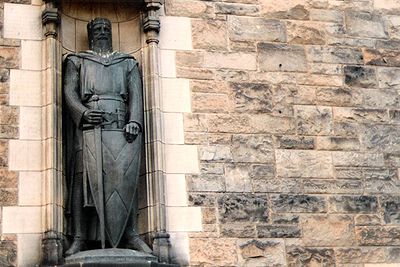
Scottish National War Memorial
The Scottish National War Memorial is located in Edinburgh Castle, and commemorates Scottish soldiers, and those serving with Scottish regiments, who died in the two world wars and in more recent conflicts. The monument was formally opened in 1927...
in Edinburgh Castle
Edinburgh Castle
Edinburgh Castle is a fortress which dominates the skyline of the city of Edinburgh, Scotland, from its position atop the volcanic Castle Rock. Human habitation of the site is dated back as far as the 9th century BC, although the nature of early settlement is unclear...
. Carrick was responsible for the small carved virtues of ‘Courage’ and ‘Justice’, set in the niches above the entrance, and the bronze figurative panels commemorating the Royal Engineers
Royal Engineers
The Corps of Royal Engineers, usually just called the Royal Engineers , and commonly known as the Sappers, is one of the corps of the British Army....
and Royal Artillery
Royal Artillery
The Royal Regiment of Artillery, commonly referred to as the Royal Artillery , is the artillery arm of the British Army. Despite its name, it comprises a number of regiments.-History:...
in the East Chapel (a copy of the Royal Engineers panel was recently made for the Royal Engineers Museum). In 1929, Carrick’s figure of Sir William Wallace was also unveiled in Edinburgh Castle. As part of the bequest of one Captain Reid, a competition was held for the design of statues depicting Scotland’s national heroes Sir William Wallace and King Robert the Bruce
Robert I of Scotland
Robert I , popularly known as Robert the Bruce , was King of Scots from March 25, 1306, until his death in 1329.His paternal ancestors were of Scoto-Norman heritage , and...
to stand in niches set into the castle wall on either side of the gateway. It was a highly controversial scheme, attracting widespread debate and criticism in the Scottish press throughout 1928 and 1929. Finally a compromise was reached, the commission for Wallace being awarded to Carrick, and Bruce awarded to the sculptor T. J. Clapperton, while Sir Robert Lorimer’s Gothic
Gothic art
Gothic art was a Medieval art movement that developed in France out of Romanesque art in the mid-12th century, led by the concurrent development of Gothic architecture. It spread to all of Western Europe, but took over art more completely north of the Alps, never quite effacing more classical...
design was chosen for the niches.
1930s Onwards
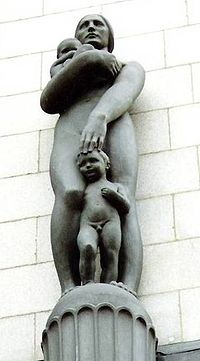
George Heriot's School
George Heriot's School is an independent primary and secondary school on Lauriston Place in the Old Town of Edinburgh, Scotland, with around 1600 pupils, 155 teaching staff and 80 non-teaching staff. It was established in 1628 as George Heriot's Hospital, by bequest of the royal goldsmith George...
in Edinburgh, Pollok House
Pollok House
Pollok House is the ancestral home of the Maxwell family, located in Pollok Country Park, Glasgow, Scotland.The house - built in 1752 and designed by William Adam - was gifted to the City of Glasgow in 1966 by Dame Anne Maxwell Macdonald, whose family had owned the estate for almost 700 years...
in Glasgow, and Dunnotar Castle. He also executed several memorial tablets featuring portraits, including that to Sir Walter Scott in Jedburgh
Jedburgh
Jedburgh is a town and former royal burgh in the Scottish Borders and historically in Roxburghshire.-Location:Jedburgh lies on the Jed Water, a tributary of the River Teviot, it is only ten miles from the border with England and is dominated by the substantial ruins of Jedburgh Abbey...
and one to the founder of the Boys' Brigade
Boys' Brigade
For the 80s New Wave band from Canada, see Boys Brigade .The Boys' Brigade is an interdenominational Christian youth organisation, conceived by William Alexander Smith to combine drill and fun activities with Christian values...
, William A. Smith
William Alexander Smith (Boys' Brigade)
Sir William Alexander Smith , the founder of the Boys' Brigade, was born in Pennyland House, Thurso, Scotland. He was the eldest son of Major David Smith and his wife Harriet...
in St. Giles' Cathedral
St. Giles' Cathedral
St Giles' Cathedral, more properly termed the High Kirk of Edinburgh, is the principal place of worship of the Church of Scotland in Edinburgh. Its distinctive crown steeple is a prominent feature of the city skyline, at about a third of the way down the Royal Mile which runs from the Castle to...
, Edinburgh. The University of Edinburgh
University of Edinburgh
The University of Edinburgh, founded in 1583, is a public research university located in Edinburgh, the capital of Scotland, and a UNESCO World Heritage Site. The university is deeply embedded in the fabric of the city, with many of the buildings in the historic Old Town belonging to the university...
also constructed the King's Buildings
King's Buildings
The King's Buildings are a campus of the University of Edinburgh in Scotland, and contains most of the schools within the College of Science and Engineering, excepting only part of the School of Informatics and the Institute of Geography, which are located at the central George Square campus...
extension and Carrick was responsible for the stone relief above the doorway of the Geology department, featuring the allegorical figure of Geology studying an ammonite
Ammonite
Ammonite, as a zoological or paleontological term, refers to any member of the Ammonoidea an extinct subclass within the Molluscan class Cephalopoda which are more closely related to living coleoids Ammonite, as a zoological or paleontological term, refers to any member of the Ammonoidea an extinct...
. In the late 1930’s he carried out all of the work on Saint Andrew's House, the new government buildings in Edinburgh, to the designs of the London sculptor William Reid Dick
William Reid Dick
Sir William Reid, Dick was a Scottish sculptor known for his innovative stylization of form in his monument sculptures and simplicity in his portraits. He became an Associate of the Royal Academy in 1921, and a Royal Academician in 1928. Dick served as president of the Royal Society of British...
. Carrick’s last prestigious work was that of the bronze groups ‘Safety’ and ‘Security’ which stand on pillars at the entrance to the Caledonian Insurance Building (now GRE Building ) in Saint Andrew Square, Edinburgh. With the outbreak of World War II
World War II
World War II, or the Second World War , was a global conflict lasting from 1939 to 1945, involving most of the world's nations—including all of the great powers—eventually forming two opposing military alliances: the Allies and the Axis...
construction work dried up and conscription claimed most of his students at the college. Carrick was forced into an early retirement and he and his wife Janet settled in their holiday cottage at Midlem in the Scottish Borders
Scottish Borders
The Scottish Borders is one of 32 local government council areas of Scotland. It is bordered by Dumfries and Galloway in the west, South Lanarkshire and West Lothian in the north west, City of Edinburgh, East Lothian, Midlothian to the north; and the non-metropolitan counties of Northumberland...
. The couple considered creating a studio at the cottage but this never happened. Carrick’s work appeared at an RSA Exhibition for the last time in 1954 when the bronze busts of his two grandchildren were displayed. He died in Galashiels
Galashiels
Galashiels is a burgh in the Scottish Borders, on the Gala Water river. The name is often shortened to "Gala" .Galashiels is a major commercial centre for the Scottish Borders...
in 1966.
Teacher and Academician

Commando Memorial
The Commando Memorial is a Category A listed monument in Scotland, dedicated to the men of the original British Commando Forces raised during World War II. Situated around a mile from Spean Bridge village, it overlooks the training areas of the Commando Training Depot established in 1942 at...
at Spean Bridge
Spean Bridge
Spean Bridge is a village, in the Highland region of Scotland.The village takes its name from the Highbridge over the River Spean on General Wade's military road between Fort William and Fort Augustus, and not from Telford's bridge of 1819 which carries the A82 over the river at the heart of the...
. An unemployed ship’s carpenter from Leith
Leith
-South Leith v. North Leith:Up until the late 16th century Leith , comprised two separate towns on either side of the river....
named Tom Whalen wandered into one of Carrick’s evening classes after spending years whittling away on pieces of scrap wood. Carrick immediately recognised his potential, and Whalen became one of the leading artists of the post war period in Scotland. Hew Lorimer
Hew Lorimer
Hew Martin Lorimer was a Scottish sculptor.He was born in Edinburgh, the second son of architect Sir Robert Lorimer. He was educated at Loretto School in Musselburgh, then at Magdalen College, Oxford University, but he left Oxford prematurely to study design and sculpture at Edinburgh College of Art...
, son of the famous architect Sir Robert Lorimer, was one of Carrick’s students and became an established artist, producing many ecclesiastical works including ‘Our Lady of the Isles
Our Lady of the Isles
Our Lady of the Isles is a sculpture of the Virgin Mary, on South Uist in the Outer Hebrides of Scotland....
’ on South Uist
South Uist
South Uist is an island of the Outer Hebrides in Scotland. In the 2001 census it had a usually resident population of 1,818. There is a nature reserve and a number of sites of archaeological interest, including the only location in Great Britain where prehistoric mummies have been found. The...
. Carrick’s influence arguably ensured that sculpture retained its status and prestige within the Academy, for example by travelling to Paris
Paris
Paris is the capital and largest city in France, situated on the river Seine, in northern France, at the heart of the Île-de-France region...
in 1938 and persuading the leading French
France
The French Republic , The French Republic , The French Republic , (commonly known as France , is a unitary semi-presidential republic in Western Europe with several overseas territories and islands located on other continents and in the Indian, Pacific, and Atlantic oceans. Metropolitan France...
sculptors of the period to travel to Edinburgh for a special exhibition of French sculpture in 1939.
External links
- Alexander Carrick, Sculptor - Site Dedicated to Carrick
- The War Memorials Trust
- The Site of Scottish National War Memorial
- Scottish War Memorials Project (public access forum recording Scotland's War Memorials including all of Carrick's War Memorials)

